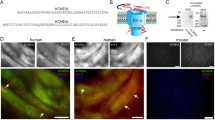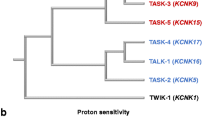Abstract
Human Kv1.5 channels (hKv1.5) conduct the ultra-rapid delayed rectifier potassium current (I Kur), which plays an important role in action potential repolarization of atrial myocytes. The present study was undertaken to examine the effects of acidic pH on hKv1.5 wild-type (WT) and its pore mutant channels heterologously expressed in Chinese hamster ovary (CHO) cells using site-directed mutagenesis combined with whole-cell patch-clamp technique. Both extracellular and intracellular acidifications equally and reversely reduced the amplitude of hKv1.5 currents. The extracellular acidification significantly shifted the voltage dependence of current activation to more depolarized potentials and accelerated deactivation kinetics of the current. The ancillary β subunits Kvβ1.3 and Kvβ1.2, known to modify the pharmacological sensitivities of hKv1.5, enhanced the extracellular proton-induced inhibitory effect on hKv1.5 current. In addition, several mutants (T462C, T479A, T480A, and I508A) exhibited significantly higher sensitivity to acidic pH-induced inhibition compared with WT channel, whereas the inhibitory effect of acidic pH was markedly reduced in H463G mutant. These observations indicate that (1) extracellular acidification modifies hKv1.5 gating and activity, (2) β subunits and several residues (T462, T479, T480, and I508) play critical roles in determining the sensitivity of the channel to acidic exposure, and (3) H463 may be a critical sensor for the channel inhibition by extracellular protons.







Similar content being viewed by others
References
Arias C, Guizy M, David M, Marzian S, Gonzalez T, Decher N, Valenzuela C (2007) Kvβ1.3 reduces the degree of stereoselective bupivacaine block of Kv1.5 channels. Anesthesiology 107:641–651. doi:10.1097/01.anes.0000282100.32923.5c
Axford TC, Dearani JA, Khait I, Park WM, Patel MA, Doursounian M, Neuringer L, Valeri CR, Khuri SF (1992) Electrode-derived myocardial pH measurements reflect intracellular myocardial metabolism assessed by phosphorus 31-nuclear magnetic resonance spectroscopy during normothermic ischemia. J Thorac Cardiovasc Surg 103:902–906, discussion 906-907
Bai JY, Ding WG, Kojima A, Seto T, Matsuura H (2015) Putative binding sites for arachidonic acid on the human cardiac Kv 1.5 channel. Br J Pharmacol 172:5281–5292. doi:10.1111/bph.13314
Cheng YM, Fedida D, Kehl SJ (2008) External Ba2+ block of human Kv1.5 at neutral and acidic pH: evidence for Ho +-induced constriction of the outer pore mouth at rest. Biophys J 95:4456–4468. doi:10.1529/biophysj.108.133165
Cheng YM, Fedida D, Kehl SJ (2010) Kinetic analysis of the effects of H+ or Ni2+ on Kv1.5 current shows that both ions enhance slow inactivation and induce resting inactivation. J Physiol 588:3011–3030. doi:10.1113/jphysiol.2010.191544
Claydon TW, Vaid M, Rezazadeh S, Kwan DC, Kehl SJ, Fedida D (2007) A direct demonstration of closed-state inactivation of K+ channels at low pH. J Gen Physiol 129:437–455. doi:10.1085/jgp.200709774
Decher N, Kumar P, Gonzalez T, Pirard B, Sanguinetti MC (2006) Binding site of a novel Kv1.5 blocker: a “foot in the door” against atrial fibrillation. Mol Pharmacol 70:1204–1211. doi:10.1124/mol.106.026203
Decher N, Kumar P, Gonzalez T, Renigunta V, Sanguinetti MC (2005) Structural basis for competition between drug binding and Kvβ1.3 accessory subunit-induced N-type inactivation of Kv1.5 channels. Mol Pharmacol 68:995–1005. doi:10.1124/mol.105.011668
Decher N, Pirard B, Bundis F, Peukert S, Baringhaus KH, Busch AE, Steinmeyer K, Sanguinetti MC (2004) Molecular basis for Kv1.5 channel block: conservation of drug binding sites among voltage-gated K+ channels. J Biol Chem 279:394–400. doi:10.1074/jbc.M307411200
Elinder F, Madeja M, Arhem P (1996) Surface Charges of K channels. Effects of strontium on five cloned channels expressed in Xenopus oocytes. J Gen Physiol 108:325–332
Fedida D, Wible B, Wang Z, Fermini B, Faust F, Nattel S, Brown AM (1993) Identity of a novel delayed rectifier current from human heart with a cloned K+ channel current. Circ Res 73:210–216
Feng J, Wible B, Li GR, Wang Z, Nattel S (1997) Antisense oligodeoxynucleotides directed against Kv1.5 mRNA specifically inhibit ultrarapid delayed rectifier K+ current in cultured adult human atrial myocytes. Circ Res 80:572–579
Gong YZ, Ding WG, Wu J, Tsuji K, Horie M, Matsuura H (2008) Cinnamyl-3,4-dihydroxy-alpha-cyanocinnamate and nordihydroguaiaretic acid inhibit human Kv1.5 currents independently of lipoxygenase. Eur J Pharmacol 600:18–25. doi:10.1016/j.ejphar.2008.10.010
Gonzalez T, Navarro-Polanco R, Arias C, Caballero R, Moreno I, Delpon E, Tamargo J, Tamkun MM, Valenzuela C (2002) Assembly with the Kvβ1.3 subunit modulates drug block of hKv1.5 channels. Mol Pharmacol 62:1456–1463
Jager H, Grissmer S (2001) Regulation of a mammalian Shaker-related potassium channel, hKv1.5, by extracellular potassium and pH. FEBS Lett 488:45–50
Kehl SJ, Eduljee C, Kwan DC, Zhang S, Fedida D (2002) Molecular determinants of the inhibition of human Kv1.5 potassium currents by external protons and Zn2+. J Physiol 541:9–24
Kwan DC, Fedida D, Kehl SJ (2006) Single channel analysis reveals different modes of Kv1.5 gating behavior regulated by changes of external pH. Biophys J 90:1212–1222. doi:10.1529/biophysj.105.068577
Olson TM, Alekseev AE, Liu XK, Park S, Zingman LV, Bienengraeber M, Sattiraju S, Ballew JD, Jahangir A, Terzic A (2006) Kv1.5 channelopathy due to KCNA5 loss-of-function mutation causes human atrial fibrillation. Hum Mol Genet 15:2185–2191. doi:10.1093/hmg/ddl143
Orchard CH, Cingolani HE (1994) Acidosis and arrhythmias in cardiac muscle. Cardiovasc Res 28:1312–1319
Orchard CH, Kentish JC (1990) Effects of changes of pH on the contractile function of cardiac muscle. Am J Physiol 258:C967–981
Ravens U, Wettwer E (2011) Ultra-rapid delayed rectifier channels: molecular basis and therapeutic implications. Cardiovasc Res 89:776–785. doi:10.1093/cvr/cvq398
Rezazadeh S, Claydon TW, Fedida D (2006) KN-93 (2-[N-(2-hydroxyethyl)]-N-(4-methoxybenzenesulfonyl)]amino-N-(4-chlorocinnamyl)-N -methylbenzylamine), a calcium/calmodulin-dependent protein kinase II inhibitor, is a direct extracellular blocker of voltage-gated potassium channels. J Pharmacol Exp Ther 317:292–299. doi:10.1124/jpet.105.097618
Snyders DJ, Yeola SW (1995) Determinants of antiarrhythmic drug action. Electrostatic and hydrophobic components of block of the human cardiac hKv1.5 channel. Circ Res 77:575–583
Starkus JG, Varga Z, Schonherr R, Heinemann SH (2003) Mechanisms of the inhibition of Shaker potassium channels by protons. Pflugers Arch 447:44–54. doi:10.1007/s00424-003-1121-0
Steidl JV, Yool AJ (1999) Differential sensitivity of voltage-gated potassium channels Kv1.5 and Kv1.2 to acidic pH and molecular identification of pH sensor. Mol Pharmacol 55:812–820
Trapani JG, Korn SJ (2003) Effect of external pH on activation of the Kv1.5 potassium channel. Biophys J 84:195–204. doi:10.1016/S0006-3495(03)74842-5
Uebele VN, England SK, Chaudhary A, Tamkun MM, Snyders DJ (1996) Functional differences in Kv1.5 currents expressed in mammalian cell lines are due to the presence of endogenous Kvβ2.1 subunits. J Biol Chem 271:2406–2412
Uebele VN, England SK, Gallagher DJ, Snyders DJ, Bennett PB, Tamkun MM (1998) Distinct domains of the voltage-gated K+ channel Kvβ1.3 β-subunit affect voltage-dependent gating. Am J Physiol 274:C1485–1495
Valenzuela C, Delpon E, Franqueza L, Gay P, Perez O, Tamargo J, Snyders DJ (1996) Class III antiarrhythmic effects of zatebradine. Time-, state-, use-, and voltage-dependent block of hKv1.5 channels. Circulation 94:562–570
Wang Z, Fermini B, Nattel S (1993) Sustained depolarization-induced outward current in human atrial myocytes. Evidence for a novel delayed rectifier K+ current similar to Kv1.5 cloned channel currents. Circ Res 73:1061–1076
Wang Z, Kiehn J, Yang Q, Brown AM, Wible BA (1996) Comparison of binding and block produced by alternatively spliced Kvbeta1 subunits. J Biol Chem 271:28311–28317
Wu J, Ding WG, Matsuura H, Tsuji K, Zang WJ, Horie M (2009) Inhibitory actions of the phosphatidylinositol 3-kinase inhibitor LY294002 on the human Kv1.5 channel. Br J Pharmacol 156:377–387. doi:10.1111/j.1476-5381.2008.00017.x
Yan GX, Kleber AG (1992) Changes in extracellular and intracellular pH in ischemic rabbit papillary muscle. Circ Res 71:460–470
Yang Y, Li J, Lin X, Yang Y, Hong K, Wang L, Liu J, Li L, Yan D, Liang D, Xiao J, Jin H, Wu J, Zhang Y, Chen YH (2009) Novel KCNA5 loss-of-function mutations responsible for atrial fibrillation. J Hum Genet 54:277–283. doi:10.1038/jhg.2009.26
Acknowledgments
This study was supported by Grant-in-Aid for Scientific Research (No. 25460287 to Hiroshi Matsuura) from The Japan Society for the Promotion of Science.
Author information
Authors and Affiliations
Corresponding authors
Ethics declarations
Conflict of interest
The authors have no conflict of interest to declare.
Additional information
Shuang Wang and Wei-Guang Ding contributed equally to this work.
Rights and permissions
About this article
Cite this article
Wang, S., Ding, WG., bai, JY. et al. Regulation of human cardiac Kv1.5 channels by extracellular acidification. Pflugers Arch - Eur J Physiol 468, 1885–1894 (2016). https://doi.org/10.1007/s00424-016-1890-x
Received:
Revised:
Accepted:
Published:
Issue Date:
DOI: https://doi.org/10.1007/s00424-016-1890-x




